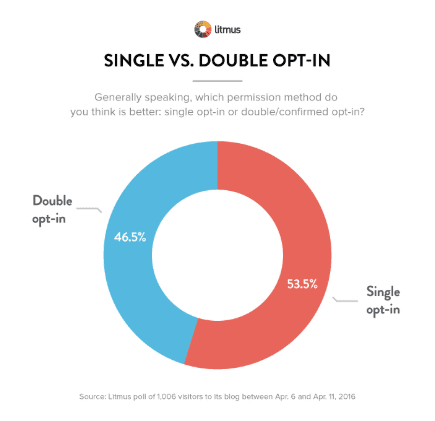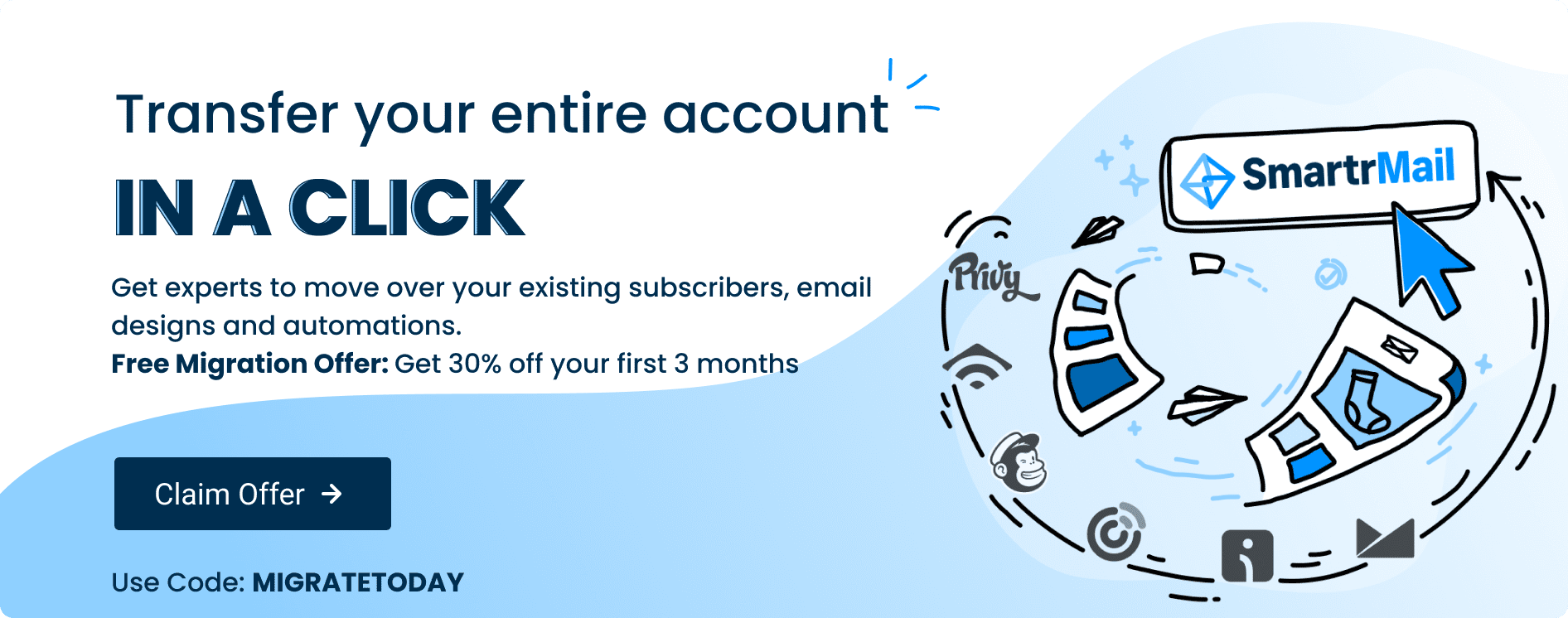So you’ve just finished setting up your email marketing. Your new email list is waiting for subscribers to come in from all the sign up forms you put on your website and possibly a pop-up or two. One question remains however: Should I require double opt-in when people sign up?
A deceptively simple question that has email marketers divided on what you should do. Many on both sides of the debate have quite strong opinions on the matter. And, as you can see from Litmus’ poll on which method is better, preference is fairly evenly split, with just a slight tendency towards preferring single opt-in.

In this article we’ll outline the difference between single and double opt-in and the reason before both methods.
What Is Double Opt-In?
Double opt-in is the process of signing up to an email list by engaging in two separate steps. The first step is the same as with single opt-in, the user enters their email address in a sign-up form and submits the request. However instead of being automatically added to the list, they are instead sent an email straight away asking them to confirm their intention to subscribe. This email will contain a link to click in order to make this confirmation. Once this link is clicked, the person is added to the mailing list and will receive future emails.
This ensures that only those who truly want to be on the list make it through. Even though the process of entering one’s email address into a form and hitting ‘Sign Up’ might seem like one has sufficiently signalled their intention to be on the list, this approach has its advantages.

The Rationale Behind Double Opt-In
Chances are you’ve already experienced the double opt-in process when signing up to an email list, and even though it might be frustrating, there are several reasons you should consider implementing the process for your signups. Here are the main benefits that double opt-in will have on your email marketing:
Helps to ensure compliance with data privacy regulations
If you work in the digital space, chances are that you’ve heard about the GDPR, the European Union’s regulatory framework governing personal data. The GDPR has increased the popularity of double opt-in given that it guarantees the right of people residing in the EU that their personal data can only be used after they provide unambiguous consent. This includes the collection and use of people’s email addresses. You can learn more about the GDPR and its implications here.
Double opt-in gives email marketers clear permission and proof that a person agreed to have their email address stored on the mailing list and be emailed marketing material. This is because it practically eliminates the chance of people accidentally signing up without realizing and stops people from signing up another person’s email address without their consent. With single opt-in, both scenarios would result in someone’s email address being added to a mailing list they never wanted to be on.
It is important to note, however, that the GDPR and other data privacy regulations around the world do NOT require double opt-in. Rather enabling double opt-in provides extra assurance that the collection of email addresses is compliant.
Improves the quality of your list
Double opt-in also helps to reduce the number of people signing up to your list despite not being all that interested in receiving your emails.
The process of having to log into one’s account, open the email and click on the confirmation link will only be completed by those truly wanting to receive your emails. Anyone who entered their address in one of your forms out of impulsivity or vague curiosity will be less likely to follow through all these steps. This improves the quality of the leads on your list. Having a higher quality list means better open and click through rates too.
Together this means that your leaner and cleaner email list will pack more of a punch at getting sales. With virtually all email service providers also charging based on the size of your list, this will likely reduce your expenses too.
Reduces your bounce rate
Sending a confirmation email before adding someone to your list can help reduce your bounce rate in two ways.
Firstly you’ll avoid having any addresses with typos in them appearing on your list. Emails sent to mistyped addresses will often fail to deliver simply because no such address exists. Those who entered their email address wrongly will also be waiting to receive a confirmation email that’ll never arrive. This will often prompt them to re-enter their address a second time making sure they spell it correctly. With single opt-in the subscriber may never have realized their mistake, meaning you may’ve lost a valuable subscriber.
The other way double opt-in can also reduce your bounce rate is by preventing people signing up with fake email addresses. This is a particularly important point if you’re acquiring addresses using a lead magnet such as a free ebook.
If you’re requiring that people enter their email address in order to obtain your offer, then you’ll almost certainly get people trying to get away with entering a fake address. Trying to send an email to these addresses will then result in a bounce.
Should you begin to experience too many bounces, then your email deliverability will suffer as a result. That is, you might find that more and more of your emails to legitimate addresses of those interested in hearing from you are heading to the spam folder instead.


Advantages of Single Opt-In
Despite all of the benefits double opt-in can bring, there is one glaring issue with it: Many people fail to complete the second step. Many of these people would’ve actually wanted to be on your list too.
Some people may not realize that they had to click on confirmation link to start receiving emails, others might get distracted and forget about it, the email might be sent to the junk folder and never seen, or someone might just get frustrated with the process and change their mind. Someone might have signed up on their phone but only check emails on their laptop. By the time they log into their emails they could easily have changed their mind.
Whatever the reason, double opt-in is likely to significantly reduce the number of quality leads on your email list. At the end of the day this can translate into lost sales and lower revenue for your business.
Single opt-in does not suffer from any of these issues.
Given the sheer number of distractions and the short attention spans many people have while online, you’ll want to make it as easy and seamless as possible. The more difficult it is to sign up, the less people you’ll get on your list.
A Cirque du Soleil case study cited in Clickz, for instance, found that 1 in 5 people fail to confirm their subscription during the double opt-in process. That means for every 100 people actively signing up through your website forms, 20 will never make in onto your list. That’s 20 people who won’t see your marketing material in their inbox and convert as a result.
Even though single opt-in will also result in more lower quality leads on your list as well as possible fake addresses, it will also result in more quality lead. Every subscriber you miss out on because of the extra step double opt-in requires is a lost potential conversion, sale, and profit.
Sign-up to our newsletter and receive a free eBook with hidden Email Marketing Tips
Which Method Is Best?
There are clear benefits to both single and double opt-in, so unfortunately this question doesn’t have an easy answer.
While double opt-in has the potential to keep your email list healthy over the long term, cleaning your list on a regular basis will keep a single opt-in list as clean if not cleaner. Which method you prefer to use to maintain your list hygiene might simply come down to how much time you have to manage your email marketing.
Surprisingly there are very few studies that have been done looking at the effect of single versus double opt-in on email engagement. There has been one study by GetResponse that looked the effect on click through rates. It found that the click through rate for lists with double opt-in was twice that of lists with single opt-in.
If you want to enable double opt-in to help ensure compliance with the GDPR then you might want to only enable it for some lists. With SmartrMail, you can choose to only require double opt-in for people within the EU while people outside of the EU can signup with just one step. This helps you to ensure compliance while not missing out of signups of people the GDPR doesn’t apply to.
To learn more about more about double opt-in and how to enable double opt-in only for people in the EU, click here.
Now that you have an overview of the advantages of both approaches as well as their drawbacks, you can make an informed choice as to which is best for your situation.








